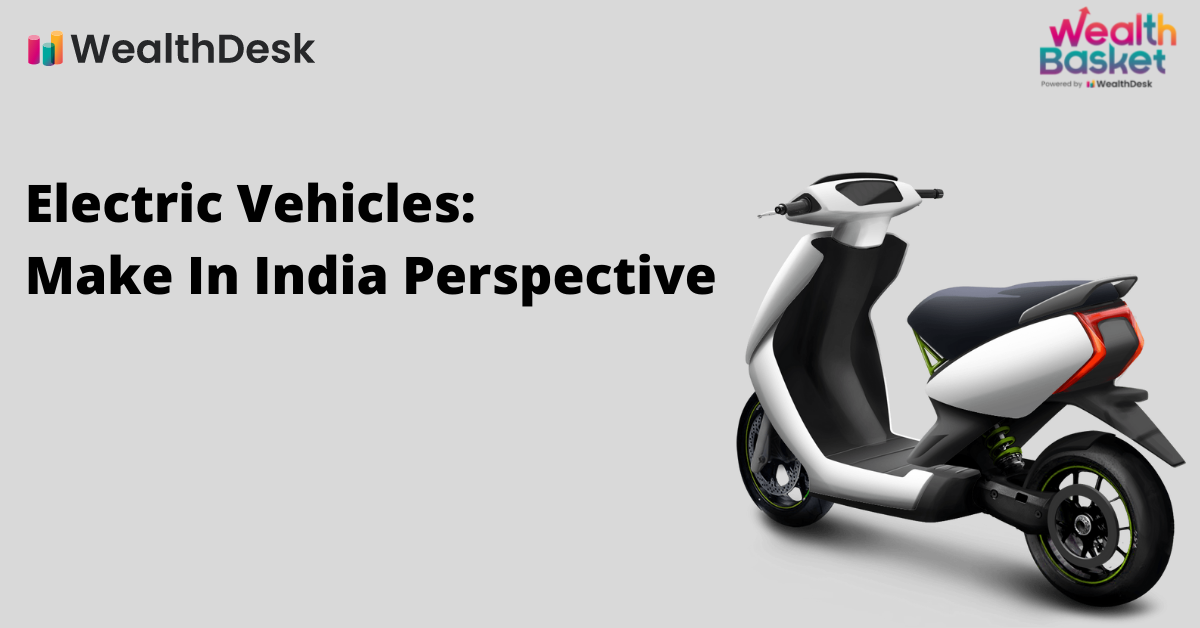As the ongoing climate crisis enters a critical stage, we look at one proposed solution: electric vehicles. The electric vehicle industry in India is an infant industry and thus is incentivised by central and state governments. It is an exciting space that holds great potential for growth with exciting ventures like Ola e-Scooter factories that aim to fulfill the global demand for electric scooters and initiatives by Tata and Mahindra.
What makes the EV industry profitable
Due to the climate crisis concerns, globally, we see a shift towards renewable energy. A significant contributor to climate change is the greenhouse gas emissions coming from fossil fuels. As fossil fuels are a limited resource, overdependence on them can be harmful.
Thus, electric vehicles that offer an alternative to traditional vehicles are one of the most recommended solutions to the climate crisis. Due to the gravity of the situation, renewable energy and electric vehicles have become highly incentivised industries.
In India, state governments give electric vehicle buyers various incentives to boost the adoption of electric vehicles. In addition, the central government also provides incentives to electric vehicle producers.
Another attractive aspect of electric vehicles is the environment certificates that allow for a secondary income. For example, Tesla, the poster-kid of electric vehicles, has been reported to bring quarterly revenues exceeding $300 million through the sale of carbon credits.
Thus, we can see that electric vehicles have found themselves in a favourable spot where buyers are motivated by a duty to the environment and government incentives. Simultaneously, the producers are motivated by government incentives, secondary revenue through carbon credit sales, and high growth expectations.
Is India ready for Electric Vehicles (EVs)?
A major problem in the adoption of EVs is the setting up of charging stations. Unlike fossil fuel-powered vehicles that already have fuel pumps set up everywhere, the charging stations required for electric vehicles are not present in most routes. To tie up this loose end, the Indian government took the initiative to set up 6,000 charging stations across nine expressways.
GOI is also providing support of up to ₹362 crores per gigawatt in this EV sector under the production linked scheme. In addition, under FAME II (Faster Adoption and Manufacturing of Hybrid and EV), ₹1000 crores have been allocated to provide EV charging stations.
FAME India
The Department of Heavy Industry formulated the Faster Adoption and Manufacturing of (Hybrid &) Electric Vehicles in India (FAME India) Scheme in 2015 to promote the manufacturing of electric and hybrid vehicles. Phase 1 of FAME India, which was extended till 2019, focused on the following focus areas:
- Demand Creation
- Technology Platform
- Pilot Project
- Charging Infrastructure
Phase 1 covered market creation for all vehicle segments:
- 2-Wheelers
- 3-Wheelers Auto
- Passenger 4-Wheeler vehicles
- Light Commercial Vehicles and Buses
Phase-1 of FAME India was able to incentivise 2.78 lakh xEVs through total demand incentives of ₹343 crores (Approx.). Learning from the experience of Phase-1, the government launched Phase-2 for three years commencing from 1st April 2019 with an outlay of ₹10,000 crores. The focus of this phase is to promote sales and establish the necessary infrastructure for charging stations.
GOI has also developed E-Amrit, an online database, to share knowledge regarding the EV sector and dispel myths.
National Electric Mobility Mission Plan 2020 (NEMMP)
National Electric Mobility Mission Plan was set up for decreasing fuel dependencies in 2 ways. Firstly, it is aimed at reducing the reliance on fossil fuel imports. And secondly, it is aimed at reducing dependence on fossil fuels themselves.
The plan aims to achieve 6-7 million sales of hybrid and electric vehicles year on year from 2020 onwards. Through the NEMMP, the government has promised fiscal and monetary incentives to support the electric vehicles industry.
In the last 15 years, only a million EVs have been sold in India. However, the prospects of EVs look bright as the sale of electric vehicles is expected to reach 1 million vehicles this calendar year of 2022. India Energy Storage Alliance (IESA) predicts that we will reach the target of 6.34 million electric vehicles by 2027.
NEMMP is a composite scheme that uses different policy-levers:
- Demand-side incentives
Promoting research and development in technology, including:
- Battery technology
- Power electronics
- Motors
- Systems integration
- Battery management system
- Testing infrastructure
And ensuring industry participation in the same
- Supply-side incentives
- Promoting charging infrastructure
- Encouraging retro-fitment of on-road vehicles with a hybrid kit
Recent notable developments
Tesla in India
Some Indian states have been inviting Tesla, the American electric vehicle giant, after the CEO, Elon Musk, said he is facing problems in getting clearance to launch its vehicles in India. Telangana, Maharashtra, West Bengal and Punjab have invited Mr.Musk to set up his business in their states.
Last year, Tesla had sought a reduction in import duties so that its company’s high-performance electric cars could begin to sell in India. In the same year, Tesla had also received a formal invitation by Karnataka, Gujarat, Andhra Pradesh and Tamil Nadu, apart from Maharashtra and Telangana, to set up a plant.
Mercedes-Benz looking to boost EV sales in India through its sedan EV
The German automobile giant plans to locally assemble its sedan EV, EQS. In the SUV segment, Mercedes-Benz had launched the EQC model as a fully imported unit in October 2020. The EQS model will be launched in the 4th quarter of 2022 and assembled at the company’s production plant at Chakan in Maharashtra. The company has thus far taken a gradual approach to expand its EV segment in India.
Tata Motors focus on EVs
Tata Motors aims for annual sales of 50,000 units in the EV segment in FY23. If the company can deliver on the target, it will generate ₹5,000 crores in revenue for FY23 through EVs alone. The company also has a long-term vision to secure up to 20% of its revenue through the sale of EVs. Of the six SUVs expected to be launched in 2022, two are expected to be EVs.
Ola e-scooter
Ola Electric Mobility pledged to make the world’s largest electric scooter factory. The company has the ambitious goal of producing 15% of the world’s electric scooters by the summer of 2022. The project has been anticipated to boost India’s EV dreams by providing a low-cost 2-wheeler alternative to existing fossil fuel-powered 2-wheelers.
Conclusion
Thus, we can see that the EV sector in India is at an up-and-coming stage, poised to grow on the back of private sector investments and government initiatives. We also see interest from foreign automakers in India’s EV market. Since the industry is in its infancy, much growth is anticipated.
At WealthDesk, investors could explore WealthBaskets – portfolios that are built on specific themes and ideas and are managed by SEBI registered professionals.
FAQs
Tata Motors is India’s largest EV producer clocking
1,000 units every month. The company recently formed
its electric vehicle subsidiary Tata Passenger
Electric Mobility (TPEML), focusing only on
passenger electric and hybrid vehicles. In October
2021, by agreeing to sell an 11-15% stake in TPEML,
Tata Motors raised
$1 billion from investors TPG Rise Climate and ADQ. The deal
values the subsidiary at over $9 billion.
EVs have seen a rise in popularity as a part of a solution to climate change. As the world shifts to renewable energy, if automobiles moved to electric power, it would significantly decrease greenhouse gas emissions. Another advantage of EVs that is strategic in nature is that it allows countries to reduce dependency on fossil fuel imports. Thus, the fate of an economy is not impacted as much by the decisions of oil supplying countries.
Due to the small size of the EV industry, Indian automakers are dependent on imports for many components of the EV units produced in India. According to sources, as much as 70% of the components are imported. However, this figure is expected to drop as the volume of EV sales increase in India.


















